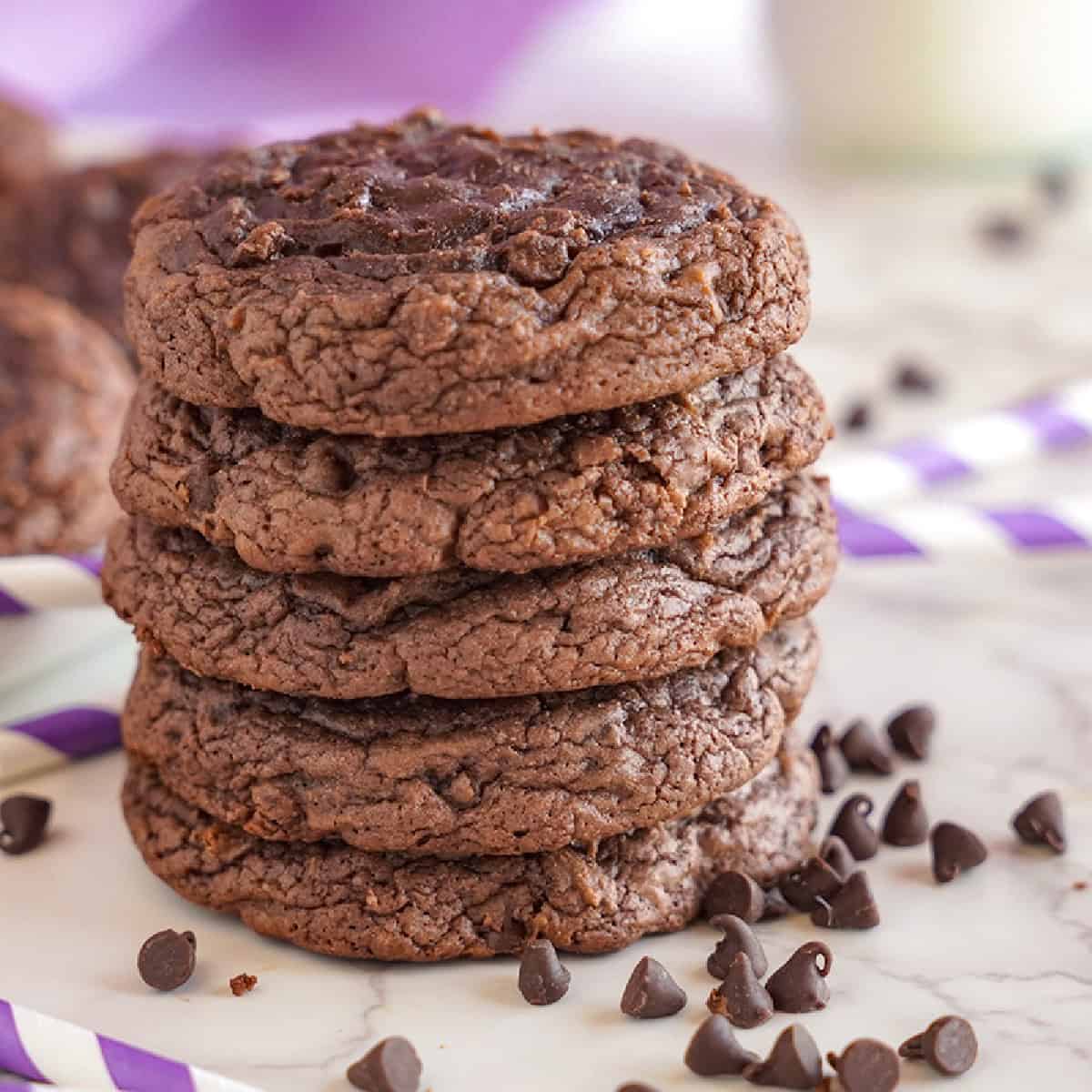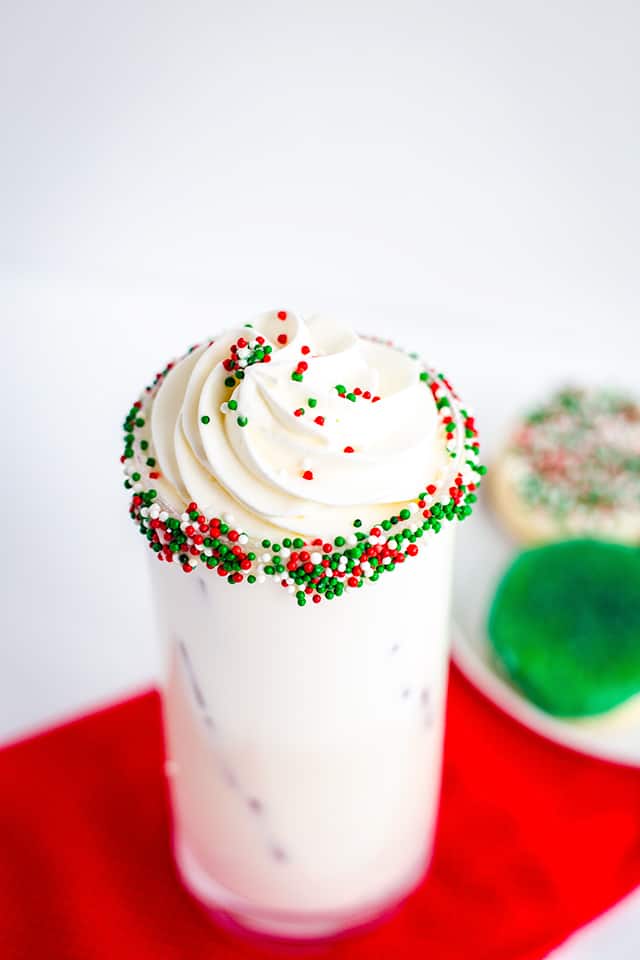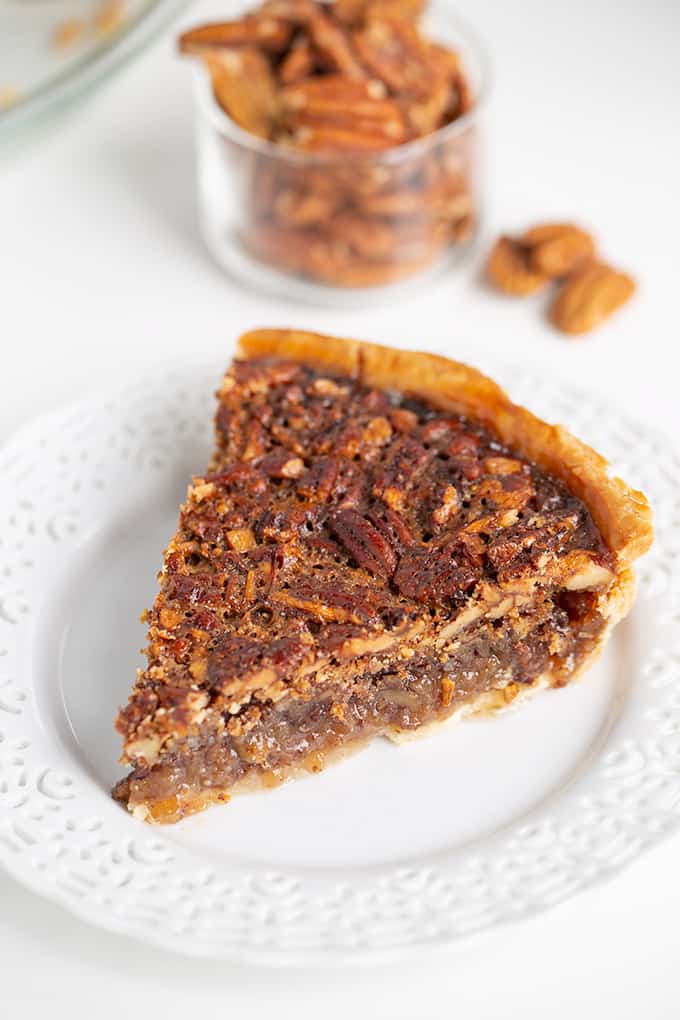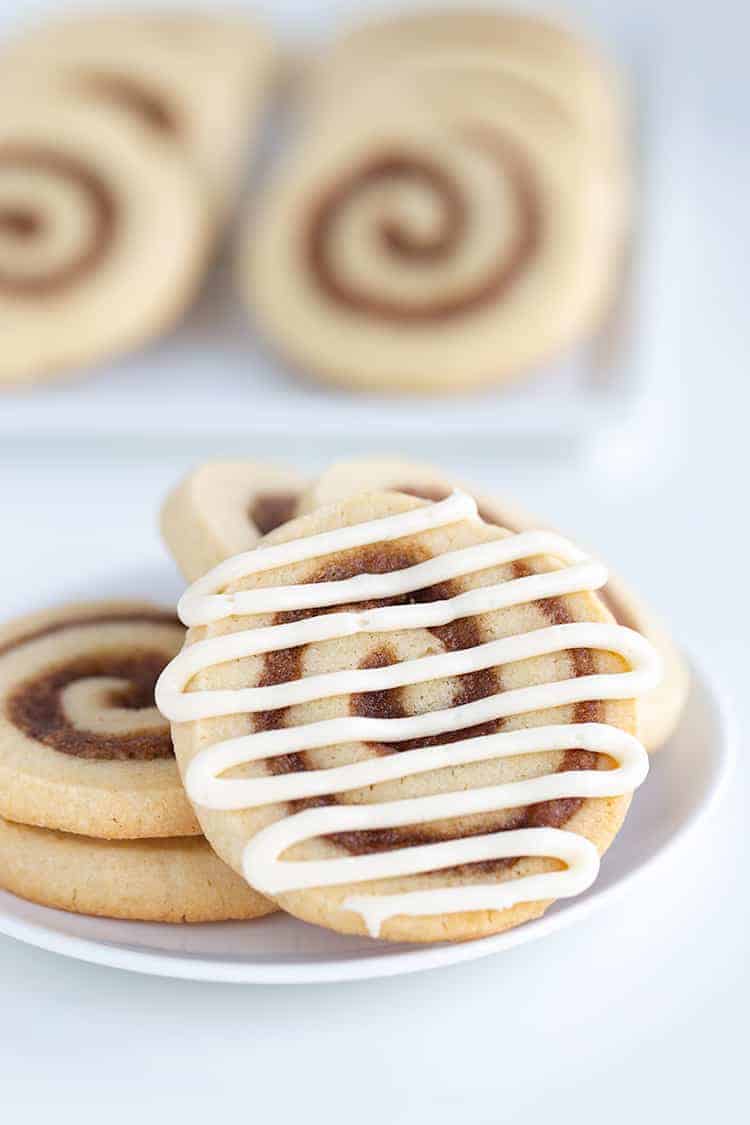Lemon Cake
This post may contain affiliate links. As an Amazon Associate I earn from qualifying purchases. Please read my disclosure policy.
This lemon cake is stunning to slice up and has the perfect balance of tart citrus and sweet buttercream in each bite. It’s a light and fluffy cake with tangy lemon curd and velvety lemon buttercream frosting.
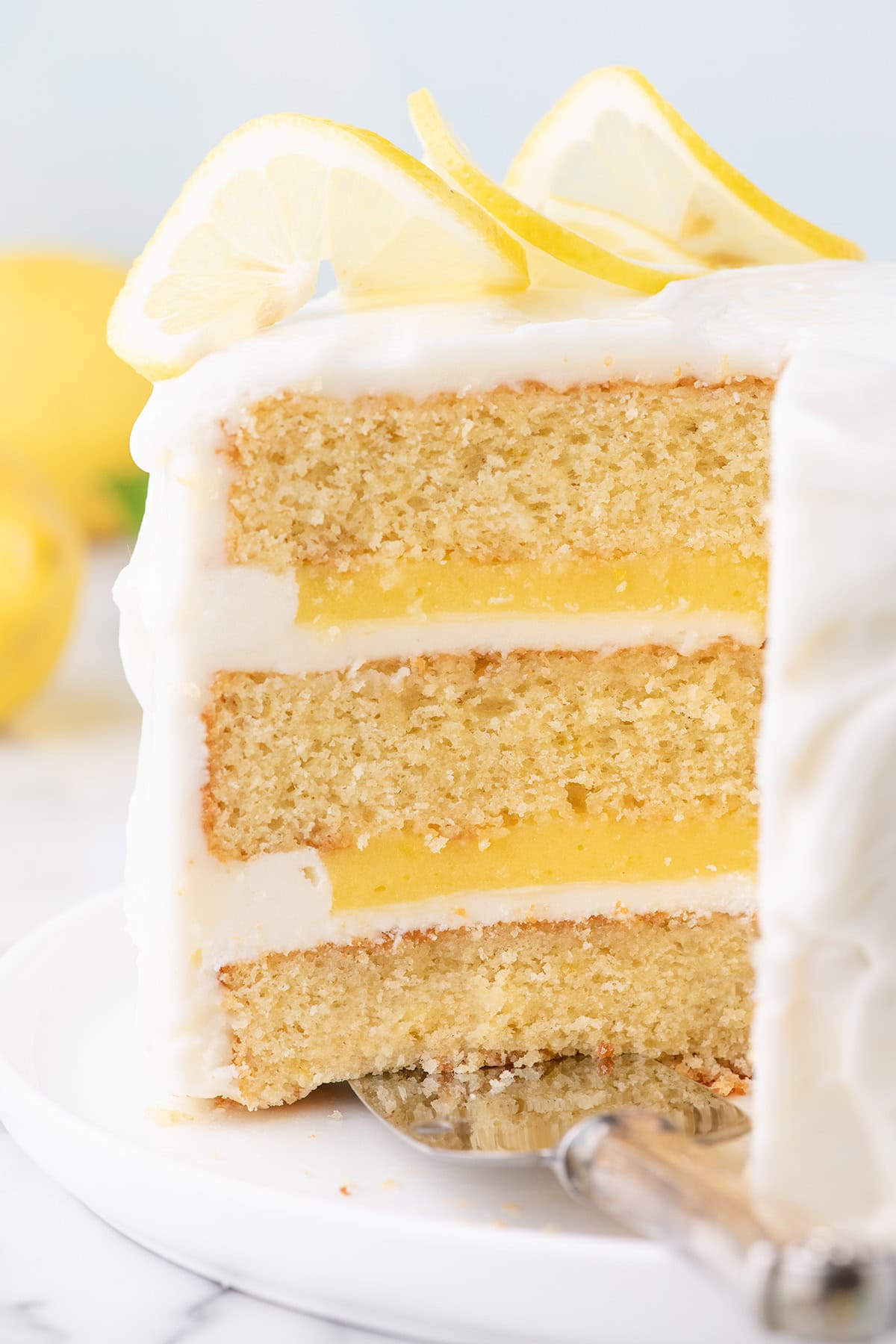
This cake is gorgeous to serve and makes a great birthday cake, holiday celebration, or even dessert for entertaining at home. You will never need an excuse to make this cake.
If you enjoy lemon recipes, try my lemon pie, lemon delight, or even this lemon poppy seed scone recipe.
Reasons to Make This Lemon Cake
- Bright and fresh flavors in each bite. This cake will tickle your tastebuds.
- Every part of this cake is made from scratch! With a step-by-step guide on how to make.
- This is a great cake for any occasion, including gifting loved ones, or giving to a friend or family member.
- You can customize the sweetness or tartness of this cake, the lemon curd, and the frosting.
Ingredients
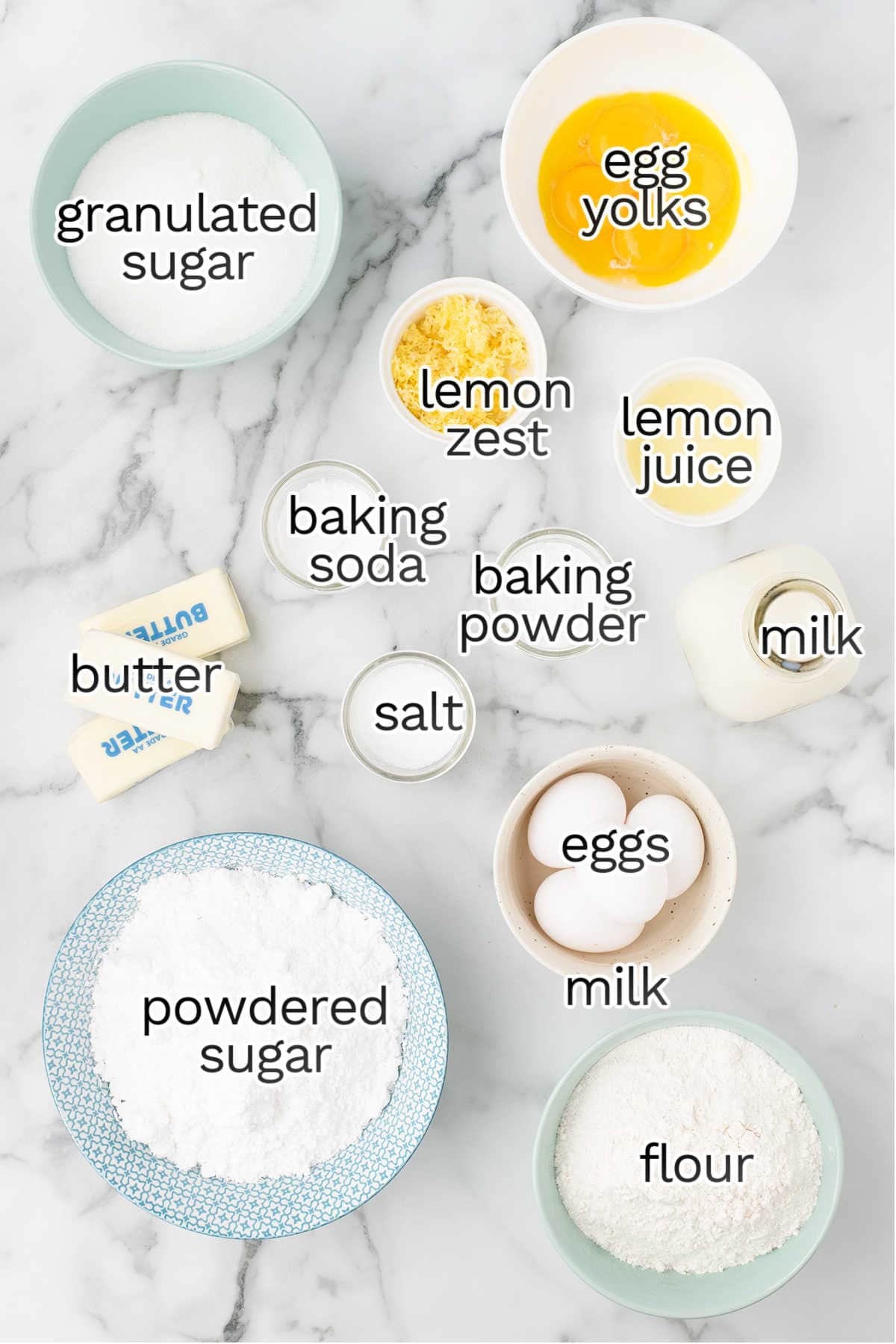
- Flour: I used all-purpose flour as the base for this cake.
- Baking Powder and Baking Soda: You will use both to help the cake rise as it bakes and create a fluffy texture.
- Salt: The salt is used to help enhance the natural flavors.
- Butter: Unsalted butter is used for this cake recipe for the cake batter, lemon curd, and frosting.
- Sugar: Sugar is used for each part of the recipe. Granulated sugar is used for the cake and lemon curd, and powdered sugar is used for the frosting.
- Lemon Zest and Lemon Juice: Opt for fresh lemons to squeeze for the lemon juice and the zest. You will also use sliced lemons for garnishing.
- Eggs: Opt for room-temperature eggs and lemon curd into the batter.
- Milk: Whole milk is used to richen the cake and help keep it moist.
Substitutions and Variations
- Gluten-Free Flour: You can use a gluten-free flour blend instead of all-purpose flour.
- Filling: You can substitute a strawberry glaze, sliced fruit, or other ingredients for the lemon curd in this recipe.
- Frosting: Feel free to use any frosting you like—vanilla buttercream, cream cheese, etc. Pick or choose any frosting you would like.
- Mix-Ins: Now, you can add diced strawberries, raspberries, or other similar items to the cake batter. You can also add white chocolate chips, crushed vanilla sandwich cookies, etc.
NOTE: This recipe has not been tested with other substitutions or variations
How To Make Lemon Cake
Bake the Cake

Start by working on the cake batter. Mix it up as directed in the recipe card. Once the cake mixture is ready, pour it into three greased 8-inch round baking pans. Bake as directed. Then, allow the cake to cool.
TIP: You can also use two 9-inch pans to make super thick layers. The thicker cake layers will need additional time to bake. If you want, use a cake leveler and slice the two 9-inch cake layers in half for a 4 layer lemon cake.
Lemon Curd
For the lemon curd, cook it in a small saucepan on the stovetop. Follow the directions for mixing and thickening the curd. Once done, place in the fridge and allow it to chill.
Lemon Frosting
I recommend using a stand mixer to whip up a velvety lemon frosting. You will place it in the fridge until you are ready to use it. You can pipe your frosting into piping bags.
Assembly of Cake
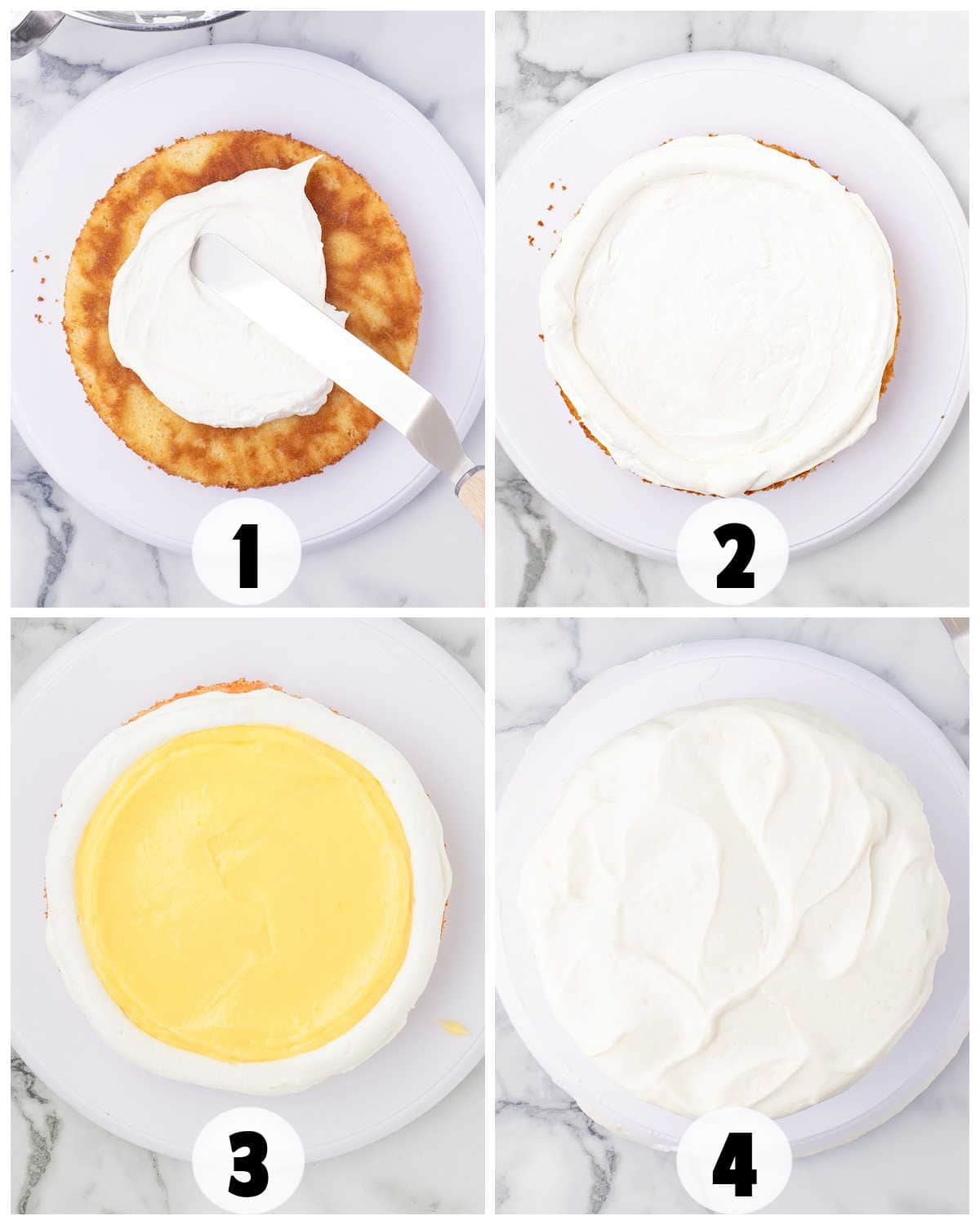
- Lay your first slab of cake on your cake board. Then, add frosting around the edges of the cake.
- Pipe a border on the outer edge of the frosting to place your curd.
- Scoop 3/4 cup of curd intox the center of the cake.
- Then, place the second layer of the cake on top. Repeat the frosting, layering it around the edge and curdling it in the center.
- Next, add your final layer of cake. You will create a crumb layer with the frosting, then refrigerate the cake for an hour.
- Remove and frost again for the final frosting layer, and garnish with lemon slices.
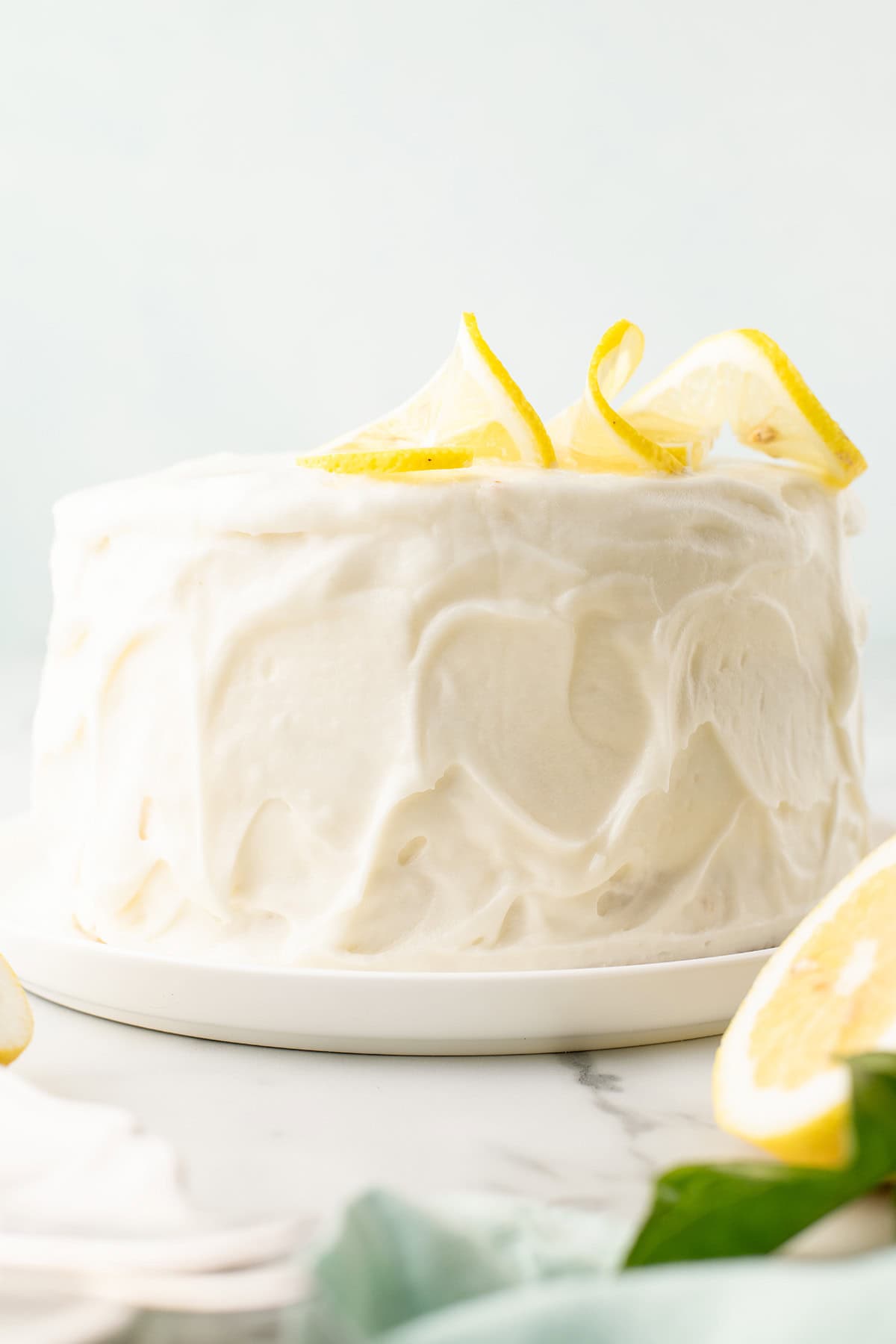
Expert Tips
Storing and Freezing
Refrigerate your cake in a sealed container for up to 3-5 days. It will dry out a bit each day.
Or you can freeze any cake you do not plan to eat immediately. Freeze for 1-2 months. Then, eat straight from the freezer or thaw in the fridge for a few hours.
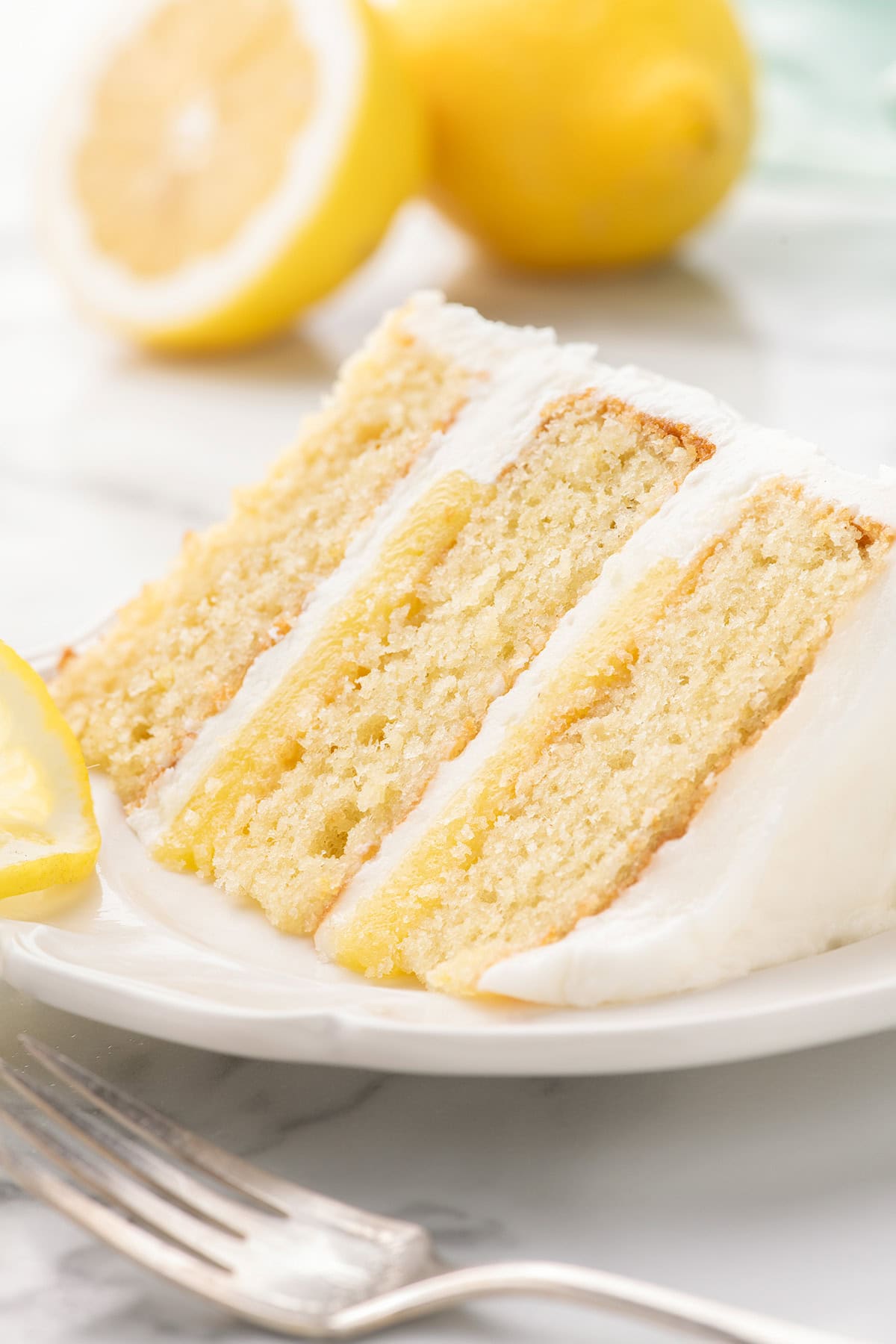
Recipe FAQs
If you would like, you can make this into a sheet-pan cake. Then, remove the cake from the pan and slice it in half. Then, add the lemon curd to the center. Next, frost and slice, and serve.
Go ahead and use a vanilla cake mix or even lemon cake mix instead of making a homemade lemon cake.
Of course! It’s not going to be as amazing as the homemade lemon curd but it will definitely be a nice shortcut.
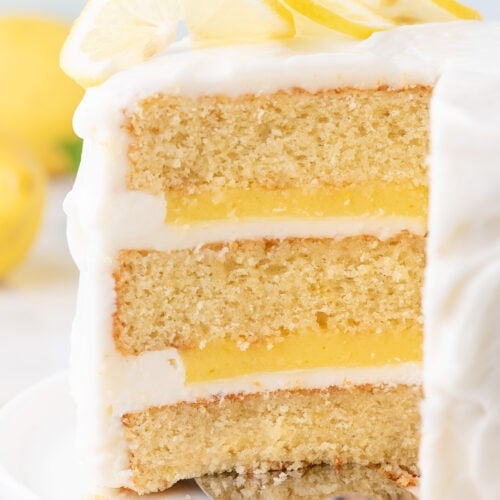
Lemon Cake
Ingredients
Cake
- 3 cups all-purpose flour sifted
- 2 ½ teaspoons baking powder
- ½ teaspoon baking soda
- ½ teaspoon salt
- 1 cup unsalted butter room temperature
- 1 ¾ cups granulated sugar
- 2 tablespoons lemon zest about 2 lemons
- 4 large eggs room temperature
- 1 cup whole milk room temperature
- ¼ cup fresh lemon juice about 1 large lemon
Lemon curd
- 5 egg yolks
- ¾ cup granulated sugar
- ¾ cup fresh lemon juice about 3 large lemons
- ½ cup unsalted butter chilled
- ¼ teaspoon salt
Frosting
- 1½ cups unsalted butter room temperature
- 7 cups powdered sugar
- ¾ cup fresh lemon juice about 3 large lemons
- ¼ teaspoon salt
- Thinly sliced lemons optional garnish
Instructions
Lemon Cake
- Preheat the oven to 350 degree F and grease three 8-inch round baking pans. Line the bottom of each pan with a parchment round.
- In a large bowl, add the flour, baking powder, baking soda, and salt. Whisk until combined and set aside.
- In the stand mixer bowl or large mixing bowl, add the butter. Using the paddle attachment or a hand mixer on medium speed, beat until light in color, about 2 to 3 minutes. Scrape down the sides of the bowl.
- Add the sugar and lemon zest. Continue beating in the stand mixer or with a hand mixer for 5 minutes until very light and fluffy.
- Add the eggs one at a time, mixing on low speed until each egg is just combined. Scrape down the sides of the bowl before adding the next egg.
- Add the milk and lemon juice. Continue mixing on low speed until just combined. The mixture will start to look curdled and that’s okay. It’s the milk reacting to the lemon juice.
- Add the dry ingredients to the wet ingredients and mix on low speed until just combined, do not overmix! Lumpy batter is okay.
- Evenly divide the batter between the three prepared baking pans. Spread the batter to the edges of the pan with an angled spatula.
- Place in the preheated oven and bake for 18-22 minutes or until the cake springs back when lightly touched. You can also insert a toothpick in the center of the cakes. If they come out clean or with moist crumbs, they’re done.
- Remove the pans from the oven and let cool while preparing the lemon curd.
Lemon Curd
- In a small saucepan, add the egg yolks and sugar. Place over low heat and whisk together until the sugar has dissolved.
- Add the lemon juice in a slow stream and continue whisking over low heat until the mixture has thickened to a thick sauce consistency.
- Remove from the heat and whisk in the salt and cold butter until completely melted.
- Pour the lemon curd in a shallow dish and lay a piece of plastic wrap over the top of the lemon curd so it’s touching the curd to prevent a skin from forming. Immediately place in the refrigerator to chill while making the frosting.
Lemon Frosting
- In the stand mixer bowl or a large mixing bowl, add the butter. Use the whisk attachment or a hand mixer and beat until the butter is light and fluffy, about 1 to 2 minutes.
- Gradually add the powdered sugar 1 cup at a time. Mix on low speed after each addition until combined.
- Add the lemon juice and salt and turn the speed to high until thoroughly incorporated.
- Place 1 cup of the frosting into a disposable piping bag and cut a dime-sized opening at the tip of the bag. Set aside.
Assembling the Cake
- Place the first layer of cake top side down onto a cake board/plate on a turntable.
- Add 1 cup of frosting to the top and using an angled spatula, spread it out to the edges in an even layer.
- Pipe a 1/2 inch border around the outer edge of the frosted layer. This will create a dam that will contain the curd filling.
- Spoon ¾ cup of the lemon curd onto the middle of the cake layer, spreading it out evenly all the way to the frosting dam with an angled spatula so it is even with the piped border.
- Place the second cake layer top side down on top of the filling. Gently press down to attach the layer to the frosting beneath it.
- Repeat the process of adding the 1 cup of frosting, 1/2 inch frosting dam, and 3/4 cup of lemon curd.
- Top with the last layer of cake top side down.
- Crumb coat the cake with 1 ½ cups of frosting. The crumb coat layer is to add a thin layer of frosting to catch all of the crumbs and seal them in and to help even out the cake surface.
- Place the cake in the refrigerator to chill for 1 hour.
- Frost the cake with the remaining frosting using an angled spatula. I like to start by adding a large scoop of frosting on the top of the cake and spread it out evenly across the top of the cake with a large angled spatula and begin working the excess frosting down the sides of the cake.
- Garnish the top with lemon slices.
Notes
- Rolling the lemon before juicing helps to release more of its juice.
- Mixing the lemon zest with the sugar releases their oils and infuses the butter mixture with a nice lemon taste.
- Adding the powdered sugar 1 cup at a time helps prevent a cloud of sugar from flying out everywhere.
Nutrition
(Nutrition facts are an estimate and not guaranteed to be accurate. Please see a registered dietitian for special diet advice.)

